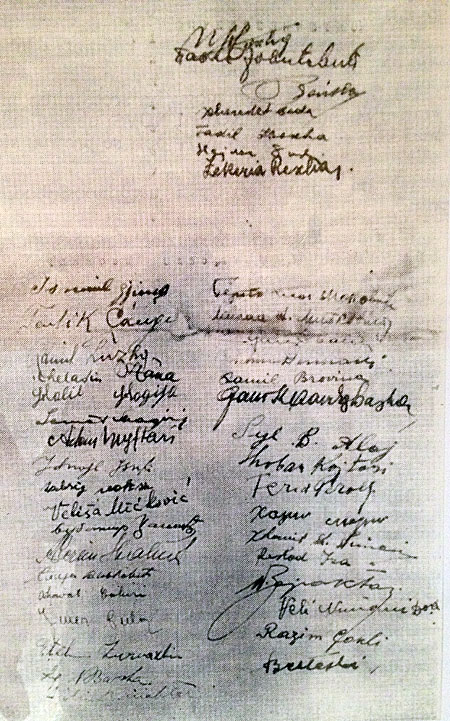| | Robert Elsie | AL Art | AL History | AL Language | AL Literature | AL Photography | Contact | |
Robert Elsie
Texts and Documents of Albanian History
BACK | AL History
1944
The Resolution of BujanKosovo Albanian sympathies were divided at the time of the Axis invasion of Yugoslavia in 1941. Although there was no particular enthusiasm for the new German and Italian administration, most Kosovo Albanians found it preferable to Serb rule. Fascist rule and the reunification with Albania were, however, short-lived. By the end of November 1944, all of Kosovo had fallen into the hands of the victorious Yugoslav partisans, and had been returned to Serb administration. Tito’s communists originally promised to let the people of Kosovo decide democratically whether they wished to be part of Albania or of Yugoslavia. This was reflected at the Conference of Bujan on 31 December 1943 – 1-2 January 1944 which passed the following resolution, one of great significance at the time for the Kosovo Albanian population. Tito, however, soon reneged on the idea, realizing that the so-called “Marxist solution” to the Kosovo question would never be accepted by Serbia. Kosovo was thus incorporated into socialist Yugoslavia against its will, under the law of 3 September 1945 and returned to another half a century of Serb rule.
Kosovo and the Dukagjin Plateau [Metohia] is a region inhabited by an Albanian majority which has always wanted to be united with Albania, as it does today. We therefore feel it is our duty to show the right way that the Albanian people must take to realise its aspirations. The only way for the Albanian people of Kosovo and the Dukagjin Plateau to be united with Albania is the common war with the other peoples of Yugoslavia against the blood-thirsty Nazi occupiers and their mercenaries. This is the only way to gain freedom – a freedom in which all the peoples, including the Albanian people, will be able to decide on their own fate with the right to self-determination, and even secession. The guarantors of this are the National Liberation Army of Yugoslavia and the National Liberation Army of Albania with which the former is closely linked. Aside from them, this will be guaranteed by our great allies: The Soviet Union, England and America (The Atlantic Charter, the Conference of Moscow and the Conference of Tehran).Executive:
Mehmet Hoxha, Pavle Jovićević, Rifat Berisha, Xhevdet Doda, Fadil Hoxha, Hajdar Dushi, Zekeria Rexha.
Members of the Council:
Ismail Gjinali, Tefik Çanga, Qamil Luzha, Xheladin Hana, Halil Haxhija, Ismet Shaqiri, Adem Miftari, Ismail Isufi, Sabrije Vokshi, Veliša Mičković, Lubomir Canić, Abdyl Kerim Ibrahim, Spira Velković, Xhevat Tahiri, Ymer Pula, Et-hem Zurnaxhiu, Ing. Nexhat Basha, Ajdin Bajraktari, Bejto Šahmanović, Milan A. Mičković, Zymer Halili, Mehmet Dermani, Qamil Brovina, Gani S. Çavdarbasha, Sul B. Alaj, Shaban Kajtazi, Ferid Perolli, Haxhi Morina, Xhavid Sh. Nimani, Reshat Isa, Mehmet Bajraktari, Veli Niman Doçi, Rasim Cokli, Sadik Bekteshi, Jaho Bajraktari, Shaban Haxhija, Alush Gashi, Beqir Ndou, Xhafer Vokshi, Sima H. Vasilević, Enver Dajçi, Maxhun Doçi Nimani.
[extract from the Resolution of the Founding Conference of the National Liberation Council of Kosovo and Metohia in the village of Bujan in the Gjakova Highlands on 31 December 1943 and 1 and 2 January 1944. Published in Këshilli Populluer i Krahinës Autonome të Kosovës-Metohis, 1943-1955 (Prishtina 1955), p. 10. Translated from the Albanian by Robert Elsie.]
TOP
